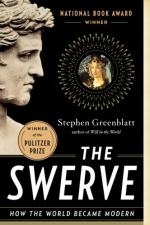|
This section contains 484 words (approx. 2 pages at 400 words per page) |

|
The Swerve Summary & Study Guide Description
The Swerve Summary & Study Guide includes comprehensive information and analysis to help you understand the book. This study guide contains the following sections:
This detailed literature summary also contains Topics for Discussion on The Swerve by Stephen Greenblatt.
The Swerve by Stephen Greenblatt is the story of a dedication that was tantamount to obsession. A highly-placed papal scribe, Poggio Bracciolini, who was secretary to the Pope - in fact, to eight popes over his long career - was also a book hunter. He was dedicated to finding the lost works of scholars, philosophers and scientists from the golden ages of ancient Greece and Rome. Every chance he got, Poggio was on the road pursuing what to him what were treasures that he could rediscover in private, public and monastic libraries throughout Europe. Monasteries in Germany and Switzerland proved to be great sources for these books of antiquity.
In 1417, Poggio rode through the German countryside and made his way to the Benedictine Abbey of Fulda. It was in the library at this monastery that Poggio uncovered the long buried and forgotten work of a little-known Roman philosopher who was a student and admirer of the great scholar and philosopher Epicurus. Poggio could not believe his discovery. Just glancing at the Latin writing, he immediately fell in love with the beauty of the words. He would later learn that the work, On the Nature of Things, was actually a doctrine that supported atheism. The irony that the papal secretary to the Pope rediscovered this lost doctrine that was anathema to organized religion and faith redounded on more than one level.
After discovering the substance of the lengthy poem, Poggio was still enchanted with its lyrical beauty despite the fact that it stood against everything that he had been taught and upended the world he had lived in if given any credence. Poggio had the chance to put the work back in hibernation to hide it again for perhaps another thousand years and thus protect his religion but he just could not hide it away. He had copies made by junior scribes and copies of it began to show up around Europe. With the advent of the printing press, more copies were made and distributed about.
Not much is known about Lucretius and how he came to the conclusions he did in his masterpiece. He ascribed to Epicureanism which advocated the avoidance of pain and the seeking of pleasure as man’s most satisfying goals. However, Lucretius also wrote of the “small particles” which was the basic construction of everything. In 300 to 440 BCE when he lived, Lucretius was speaking of atoms. What led him to his theory of small particles which turned out to be correct remains a mystery that will probably never be solved.
Poggio Bracciolini, a papal scribe, found a remarkable work written some 1,400 years before by a little-known Roman philosopher. Though Poggio remained interested in the literature of antiquity, he retired from his book-hunting soon after this discovery. He undoubtedly concluded that he had found his “Holy Grail” and that he would probably never be able to exceed that achievement.
Read more from the Study Guide
|
This section contains 484 words (approx. 2 pages at 400 words per page) |

|



